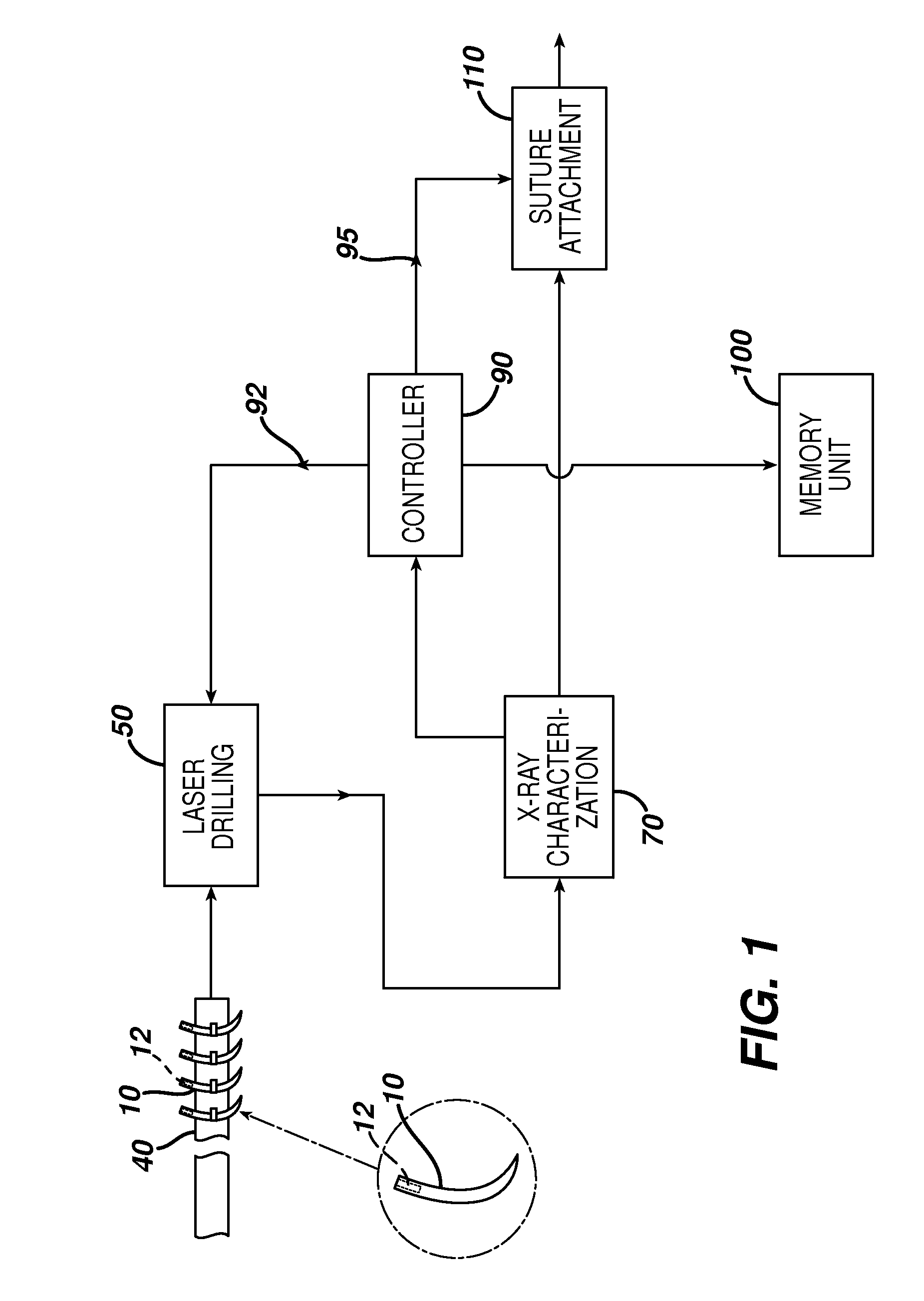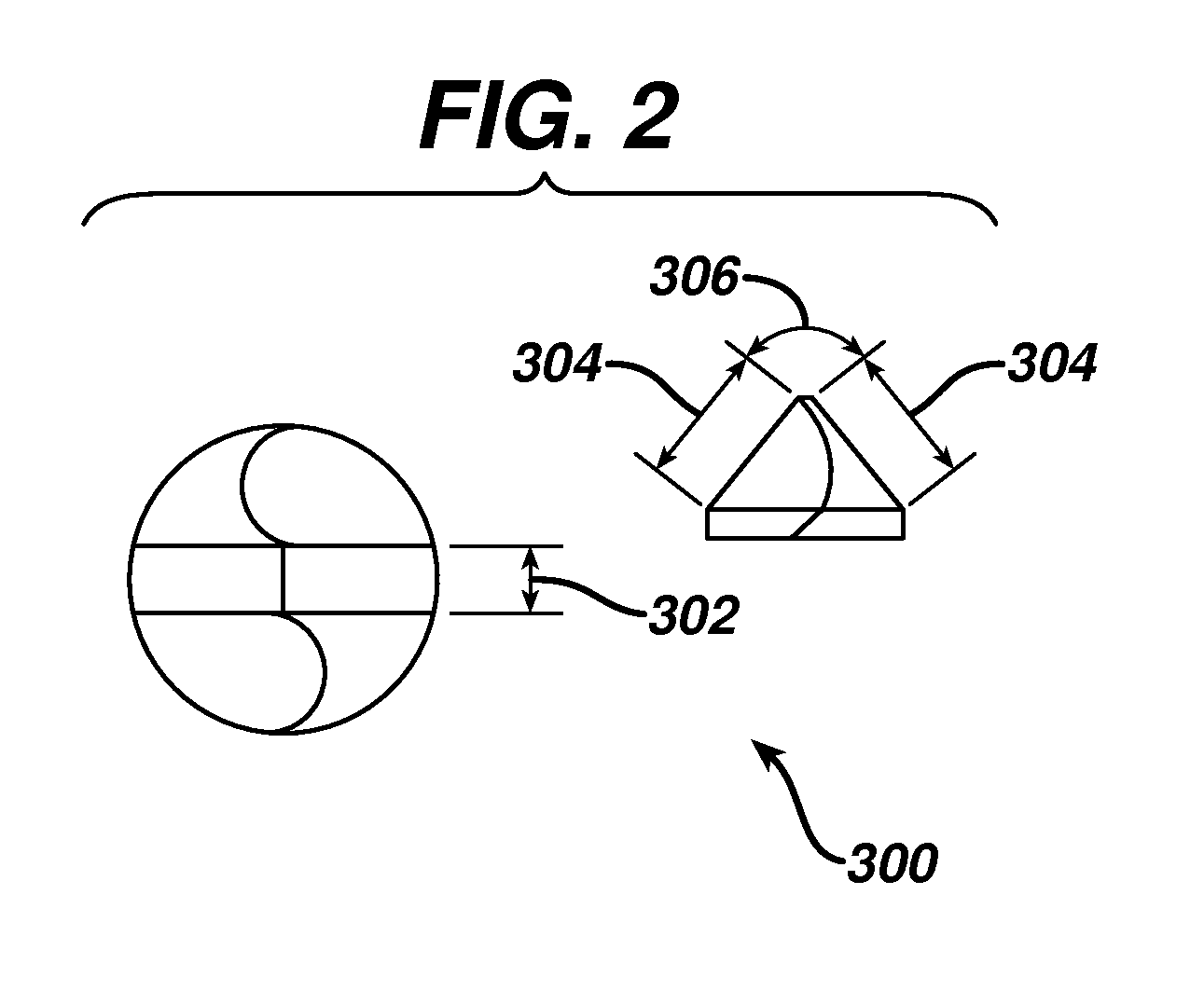However, channels, when closed (i.e., swaged), create a bump (to a lesser or greater degree) in the
distal portion of the channel.
Such bumps may be undesirable to surgeons and other medical professionals since a bump may disrupt the smooth passage of the needle through tissue.
This characteristic of channeled needles was eliminated with the introduction of mechanically drilled boreholes for suture mounting, however mechanical drilling can only be utilized for low strength alloys and large
diameter holes.
Although mechanical drilling will typically produce a borehole having relatively precise dimensions and a precise configuration, there are several disadvantages that may be associated with mechanical drilling.
These include slow drilling speeds in an automated high speed manufacturing
system,
drill wear and life, the difficulty in manufacturing production grade drills for needles having fine wire sizes, increased costs, and the inability to
drill small
diameter holes in high strength alloys in small wire sizes
Although
laser drilling overcomes these problems, laser drilled holes, on the other hand,
pose several other unique problems, although certainly manageable, that have yet to be addressed.
Laser drilled needles tend to have several issues associated with the use of a laser to
drill a borehole.
For example, in cases where the laser melts the material to form the hole, there is the potential for recast to form on the interior of the hole, and such recast may affect suture attachment.
Other issues may include the consistency of the borehole profile and the smoothness of the borehole, as well as the possibility of blow-outs.
Although
laser drilling processes have all of these advantages, as previously mentioned the boreholes drilled by lasers typically do not have the same precise dimensional configuration as mechanically drilled boreholes.
The recast can create a non-uniform hole condition which may affect suture
insertion and attachment.
A length that is too long may weaken the needle, while too short may result in needle / suture separation.
There are several disadvantages associated with the use of mechanical pin gages.
While pin gages are ideally suited for mechanically-drilled needles, they are not especially suitable for laser drilled needle manufacturing for several reasons.
First of all, pin gages are not adapted for use in high speed manufacturing processes.
Also, the pin gages used to measure very small
diameter boreholes are expensive and difficult to manufacture, and for the finer diameters are easily damaged.
In addition, the use of pin gages will not provide information with respect to the presence of re-cast.
Thus, a pin gage can only approximate the minor
diameter measurement of a laser drilled borehole, and provides no other information with respect to other important parameters such as taper, length, degree of centeredness, irregularities, degree of skewing, etc.
The presence of re-cast may cause a misrepresentation of the true minor diameter of the laser drilled hole.
Further, as mentioned above, the pin gage measurements fail to address potential variants in the borehole profile.
Statistical sampling of a batch of drilled needles may indicate that the boreholes are out of specification, requiring the destruction of an entire out-of-specification batch of needles.
Other disadvantages include: pin gage wear, whether the gage is a minus or plus in tolerance with respect to the required borehole measurement, and acceptance of boreholes that meet the pin gage criteria, but have undetected internal geometries that inhibit, or preclude subsequent suture attachment.
Pin gage measuring is a manual process and, consequently, is not a procedure that can keep pace with a high speed surgical needle manufacturing processes required in modern needle manufacturing processes and typically associated with
laser drilling.
Statistical sampling of laser drilled needles, although possible, if one were willing to accept any attendant disadvantages, is potentially prohibitive and it would not be possible to inspect a statistically relevant sample in real-time.
Therefore it is typically necessary to use a reduced sample size, which may lead to false positives, possibly resulting in the destruction of laser drilled needles that, if inspected at acceptable levels, would not result in such a loss and the commensurate expense associated with the loss of a production batch of needles.
Another
disadvantage of pin gage inspection methods includes the possible acceptance of boreholes that meet the pin gage criteria, but have undetected defects, internal geometries or configurations that inhibit, or preclude subsequent effective suture
insertion and attachment, possibly resulting in failures in the field.
As discussed above, the conventional means of measurement for drilled boreholes, i.e., plug gaging, does not work well with laser drilled holes because of the numerous attendant disadvantages.
Given the inconsistent profile of a laser hole, plug gaging only can provide the user with an indication of the minor diameter of the inconsistent profile, but fails to provide a measure of the major diameter and / or the hole profile.
This is a serious drawback, as variation on the hole profile and the differences between the minor and major hole diameters directly affects the ability to secure the suture to the needle.
Another drawback is that pin gaging is extremely time-consuming and only as accurate as the pin gage is manufactured and maintained.
Unfortunately, there are no options available other than physical destruction, specifically, mechanically cross-sectioning a needle and examining the shape of the borehole, which is difficult, laborious,
time consuming, and not cost-effective to do with a statistically significant sample size, and does not provide real
time information which can be used to control production processes.
 Login to View More
Login to View More 


